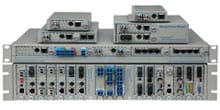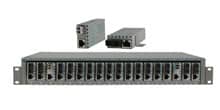- Products
- PoE Media Converters and Switches
- Ethernet & PoE Switches Product Selector
- Multi-Gigabit Ethernet and PoE Switches
- PoE PSE Commercial Switches
- PoE PSE Industrial Fiber Switches
- PoE Industrial Copper Extenders
- PoE Powered Media Converters
- PoE PSE Media Converters
- PoE Extenders & Injectors Product Selector
- Pluggable Transceivers Product Selector
- Product Lines

- iConverter Managed Multi-service Platform
- Copper to Fiber Media Converters
- Ethernet Media Converters
- 10 Gigabit Copper-to-Fiber
- 10/100/1000 Copper to 10 Gigabit Fiber
- 10/100/1000 Copper-to-Fiber with Integrated Management
- 10/100/1000 Industrial Copper-to-Fiber with Integrated Management
- 10/100/1000 Copper-to-Fiber with VLAN
- 10/100/1000 Dual Media Converter with VLAN
- Gigabit Copper-to-Fiber
- 10/100 Copper-to-Fiber with Integrated Management
- 10/100 Industrial Copper-to-Fiber with Integrated Management
- 10/100 Copper-to-Fiber with VLAN
- 10/100 Copper-to-Fiber
- Fast Ethernet Copper-to-Fiber
- Fast Ethernet Redundant Links
- 10Mbps Copper-to-Fiber
- 10Mbps Copper to Coax
- TDM Media Converters
- Serial Media Converters
- Ethernet Media Converters
- Fiber to Fiber Media Converters
- 10 Gigabit Fiber-to-Fiber Converter and Transponder
- 10 Gigabit Industrial Converter and Transponder
- SFP-to-SFP Fiber Converter and Transponder
- SFP-to-SFP Industrial Fiber Converter and Transponder
- Gigabit Fiber to-Fiber with 3 Rs
- 100/1000 Fiber-to-Fiber with 3 Rs
- Gigabit Fiber-to-Fiber
- Fast Ethernet Fiber-to-Fiber with 3 Rs
- Fast Ethernet Fiber-to-Fiber
- OC-3/STM-1 Fiber-to-Fiber
- OC-12/STM-4 Fiber-to-Fiber
- Carrier Ethernet Network Interface Devices
- CE 2.0 - 10G Demarcation NID
- CE 2.0 - 10G Demarcation and Aggregation NID
- CE 2.0 - 10/100/1000 Mult-port NID
- CE 2.0 - 10/100/1000 Mult-port NID with PoE
- CE 2.0 - 10/100/1000 8-Port NID
- SFP NID - Gigabit SFP NID
- microNID - 100/1000 compact NID
- CE 1.0 Service OAM - 10/100/1000 NID
- CE 1.0 Link OAM - 10/100/1000 Copper-to-Fiber NID
- CE 1.0 Link OAM - 10/100 Copper-to-Fiber NID
- CE 1.0 Link OAM - Gigabit Fiber-to-Fiber NID
- CE 1.0 Link OAM - Fast Ethernet Fiber-to-Fiber NID
- CWDM Multiplexers
- T1/E1 Multiplexers
- Ethernet Switch Modules
- Management System
- Chassis Options

- 1-Module Industrial Chassis

- RuggedNet Industrial Switches and Extenders
- Industrial PoE PSE Fiber Switches
- Multi-Gigabit Managed Industrial PoE+/BT Switches
- Multi-Gigabit Unmanaged Industrial PoE+/BT Switches
- 10G Managed 802.3bt PoE Switches
- 10G Unmanaged 802.3bt PoE Switches
- 10G Managed PoE+ Switches
- 10G Unmanaged PoE+ Switches
- 1G Managed PoE+ Switches
- 1G Unmanaged PoE+ Switches
- 1G Unmanaged 802.3bt PoE Switches
- 1G Managed 802.3bt PoE Switches
- Industrial Ethernet Switches
- Industrial PoE Copper Extenders
- Industrial Power Supplies

- OmniConverter Media Converter, Switches and Extenders
- PoE PSE Media Converters
- 10G Multi-Gigabit / Multi-Rate PoE Media Converter
- 10G Multi-Gigabit / Multi-Rate Media Converter
- 10/100 Multi-port PoE+ Media Converter
- 10/100 PoE+ Media Converter
- 10/100/1000 Multi-Port PoE+ Media Converter
- Industrial 10/100/1000 Multi-Port PoE+ Media Converter
- 10/100/1000 PoE+ Media Converter
- 10/100/1000 PoE++ 60W-100W Media Converter
- Industrial 10/100 Multi-port PoE+ Media Converter
- 1U Rack-Mount Shelf
- PoE PSE Compact Switches
- Multi-Gigabit Managed PoE+/BT Switches
- Multi-Gigabit Unmanaged PoE+/BT Switches
- 10G Managed 802.3bt PoE Switches
- 10G Unmanaged 802.3bt PoE Switches
- 10G Managed PoE+ Switches
- 10G Unmanaged PoE+ Switches
- 1G Managed PoE+ Switches
- 1G Unmanaged PoE+ Switches
- 1G Managed 802.3bt PoE Switches
- 1G Unmanaged 802.3bt PoE Switches
- Ethernet Switches
- PoE Copper Extenders
- Single Pair Ethernet Converters
- PoE Injectors

- miConverter Unmanaged Miniature Media Converters
- 10/100/1000 Copper-to-Fiber
- Industrial 10/100/1000 Copper-to-Fiber
- 10/100/1000 Ultra-Compact Copper-to-Fiber
- Gigabit Copper-to-Fiber
- 10/100/1000 Copper-to-Fiber PoE Powered
- 10/100 Copper-to-Fiber
- 10/100 Ultra-Compact Copper-to-Fiber
- 10/100 Copper-to-Fiber PoE Powered
- 18-Module Chassis
- Industrial 10/100 Copper-to-Fiber PoE Powered

- FlexSwitch Compact Switches
- Solutions
- Company
- Support
- How to Buy
Mastering Mounting Configurations: A Guide to Network Switch Setups

In networking, the way you mount your network switches can significantly impact performance, scalability, and maintenance. Whether setting up a small office network or managing a large-scale enterprise infrastructure, understanding the nuances of mounting configurations is crucial. This comprehensive guide will delve into various mounting options, best practices, and tips for optimizing your network switch setups.
Network Switch Mounting Option
Rack Mounting: The Standard Approach
Rack mounting is the most common method used for housing network switches in data centers and server rooms. Switches are installed on standard 19-inch racks using mounting brackets or rails. This setup offers easy accessibility, efficient cable management, and scalability.
Wall Mounting: Space-Saving Solution
Wall mounting is ideal for environments with limited floor space or where rack mounting is impractical. Switches are securely mounted on walls using brackets or mounting plates. It provides a tidy solution while ensuring proper ventilation and cable management.
Desktop Mounting: Convenience at Your Fingertips
For small office setups or home networks, desktop mounting offers simplicity and convenience. Switches are placed directly on desks or shelves, eliminating the need for additional mounting hardware. While it may lack the scalability of rack mounting, it suits smaller setups perfectly.
DIN Rail Mounting: The Industrial Specialist
DIN Rail mounting is commonly used for industrial networks and in automation applications. Network Switches have a special clip that snaps directly onto a metal rail (DIN rail). These rails are often pre-installed in cabinets and closets making it easy to install new switches.
Factors to Consider
To guarantee optimum performance and functionality, a number of elements need to be taken into account before mounting configurations are carried out.
Physical Space
Evaluate the available physical space to determine the most suitable mounting option. Consider factors such as clearance, ventilation, and accessibility for maintenance.
Cable Management
Effective cable management is essential to prevent clutter and maintain airflow around the switches. Choose mounting configurations that facilitate organized cable routing and minimize cable strain.
Environmental Conditions
Take into account the environmental conditions of the installation site, like temperature, humidity, and exposure to dust or moisture. Select mounting options that offer protection against these elements to safeguard the switch's integrity. Ensure proper ventilation around the switch, regardless of mounting method.
Accessibility
Think about how often you'll need to access the switch for maintenance or troubleshooting. Mount the device so you can easily access the ports or read the LED indicators if needed.
Mounting Procedures
Follow these step-by-step procedures to mount network switches securely and effectively:
Positioning
Identify the designated mounting location and ensure it meets the requirements outlined during the site survey. Verify clearance and accessibility for cable routing and maintenance.
Attachment
Secure the mounting brackets or rails to the mounting surface using appropriate hardware. Ensure the brackets are level and stable to support the weight of the switch.
Cable Management
Organize network cables and power cords to prevent tangling and interference. Use cable ties or management accessories to secure cables along the mounting surface and maintain neatness.
Power and Connectivity
Connect the switch to power sources and network devices using the appropriate cables. Verify connectivity and power up the switch to initiate the setup process.
FAQs
How Do You Mount a Switch?
To mount a switch, first, ensure you have the necessary tools like screws and a screwdriver. Decide on the mounting location, whether it's a rack, wall, or desktop. Align the switch with the mounting holes and secure it tightly using the appropriate hardware. Finally, double-check the connections and ensure proper airflow for optimal performance.
How Do You Mount a Switch to a Rack?
When mounting a switch to a rack, start by selecting the appropriate rack unit (U) based on the switch's size. Use mounting brackets or rails to secure the switch to the rack, ensuring it's aligned properly. Avoid over tightening the screws when tightening them to keep the switch in place. Verify that the switch is securely mounted and test for stability before proceeding.
How Do I Set Up a Network Switch?
Setting up a network switch involves several steps. Begin by connecting the switch to a power source and the network devices using Ethernet cables. Access the switch's configuration interface through a web browser or terminal session. Configure basic settings like IP address, subnet mask, and default gateway. Finally, the connections must be tested to ensure all devices can communicate effectively.
Can I Mix Different Mounting Options in the Same Network Setup?
Yes, you can mix different mounting options in the same network setup based on your requirements. For example, you might use rack mounting for core switches in a data center while opting for wall or desktop mounting for switches in branch offices. Consider factors such as space constraints, accessibility, and scalability when determining the best mounting options for your network.
Is There a Maximum Number of Switches I Can Mount in a Rack?
The maximum number of switches you can mount in a rack depends on various factors such as rack size, weight capacity, and ventilation. Refer to the rack manufacturer's specifications for weight limits and airflow requirements. Additionally, consider the physical space available in the rack and leave room for future expansion to accommodate additional switches if needed.
Conclusion
Mastering mounting configurations is essential for optimizing network switch setups. By understanding the different mounting options available and their respective benefits, network administrators can create a robust and efficient network infrastructure.
All Omnitron switches offer versatile mounting options. They can be wall-mounted, rack-mounted using a shelf, or DIN-rail mounted using DIN-rail mounting clips, providing flexibility to suit various installation scenarios. If you have any further questions or need assistance, don't hesitate to give us a call. Our support team is available 24/7 to provide pre-sale support and address any inquiries you may have. Give us a call now for expert assistance.









